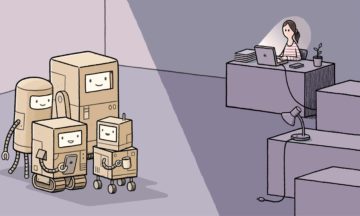David Runciman in The Guardian:
 At the 2021 Australian and US Open tennis championships, all the line judges were replaced by machines. This was, in many ways, inevitable. Not only are these machines far more accurate than any human at calling balls in or out, but they can also be programmed to make their calls in a human-like voice, so as not to disorient the players. It is a little eerie, the disembodied shriek of “Out!” coming from nowhere on the court (at the Australian Open the machines are programmed to speak with an Australian accent). But it is far less irritating than the delays required by challenging incorrect calls, and far more reliable. It takes very little getting used to.
At the 2021 Australian and US Open tennis championships, all the line judges were replaced by machines. This was, in many ways, inevitable. Not only are these machines far more accurate than any human at calling balls in or out, but they can also be programmed to make their calls in a human-like voice, so as not to disorient the players. It is a little eerie, the disembodied shriek of “Out!” coming from nowhere on the court (at the Australian Open the machines are programmed to speak with an Australian accent). But it is far less irritating than the delays required by challenging incorrect calls, and far more reliable. It takes very little getting used to.
In the slew of reports published in the 2010s looking to identify which jobs were most at risk of being automated out of existence, sports officials usually ranked very high up the list (the best known of these studies, by Carl Benedikt Frey and Michael Osborne in 2017, put a 98% probability on sports officiating being phased out by computers within 20 years). Here, after all, is a human enterprise where the single most important qualification is an ability to get the answer right. In or out? Ball or strike? Fair or foul? These are decisions that need to be underpinned by accurate intelligence. The technology does not even have to be state-of-the-art to produce far better answers than humans can. Hawk-Eye systems have been outperforming human eyesight for nearly 20 years. They were first officially adopted for tennis line calls in 2006, to check cricket umpire decisions in 2009 and, more recently, to rule on football offsides.
More here.
